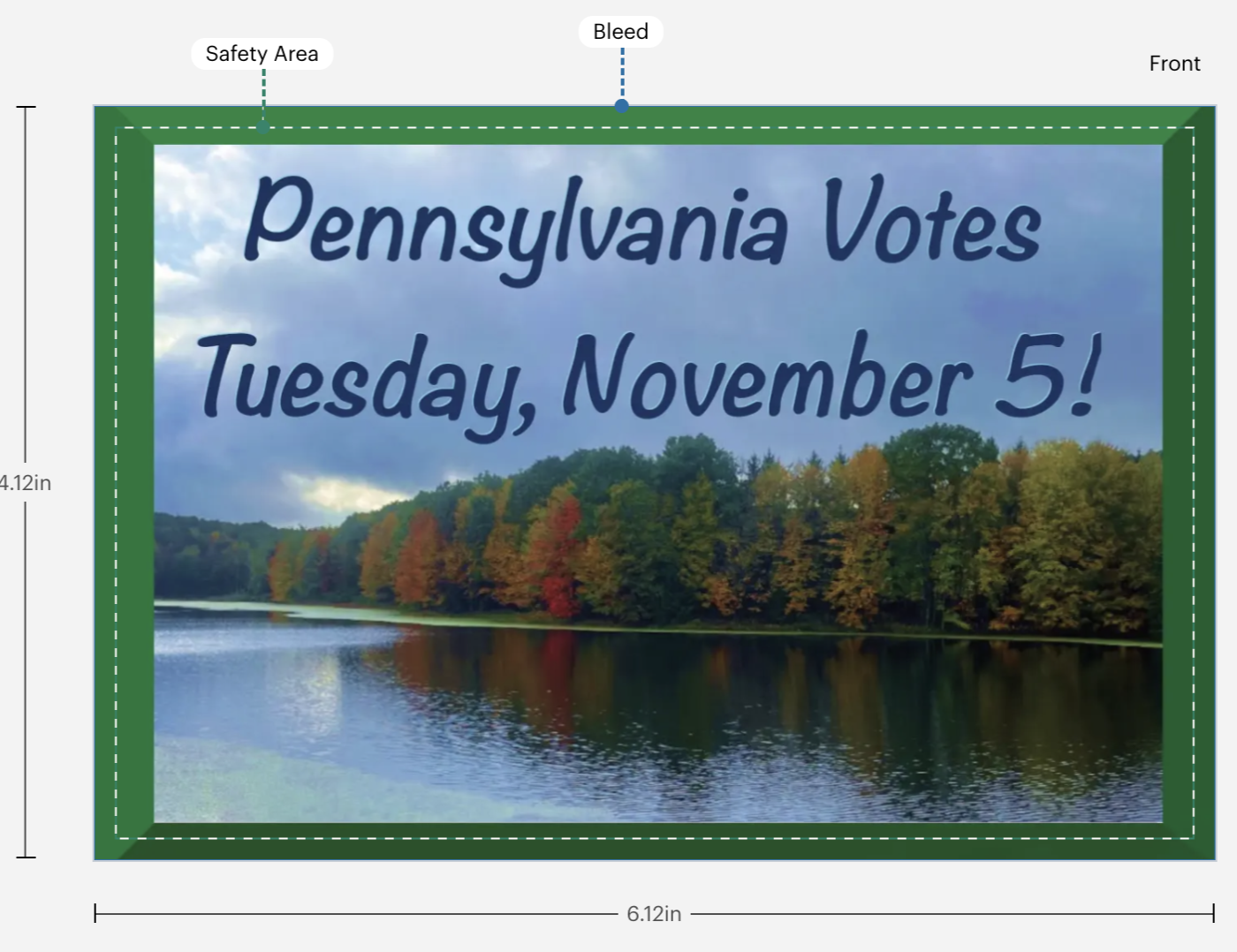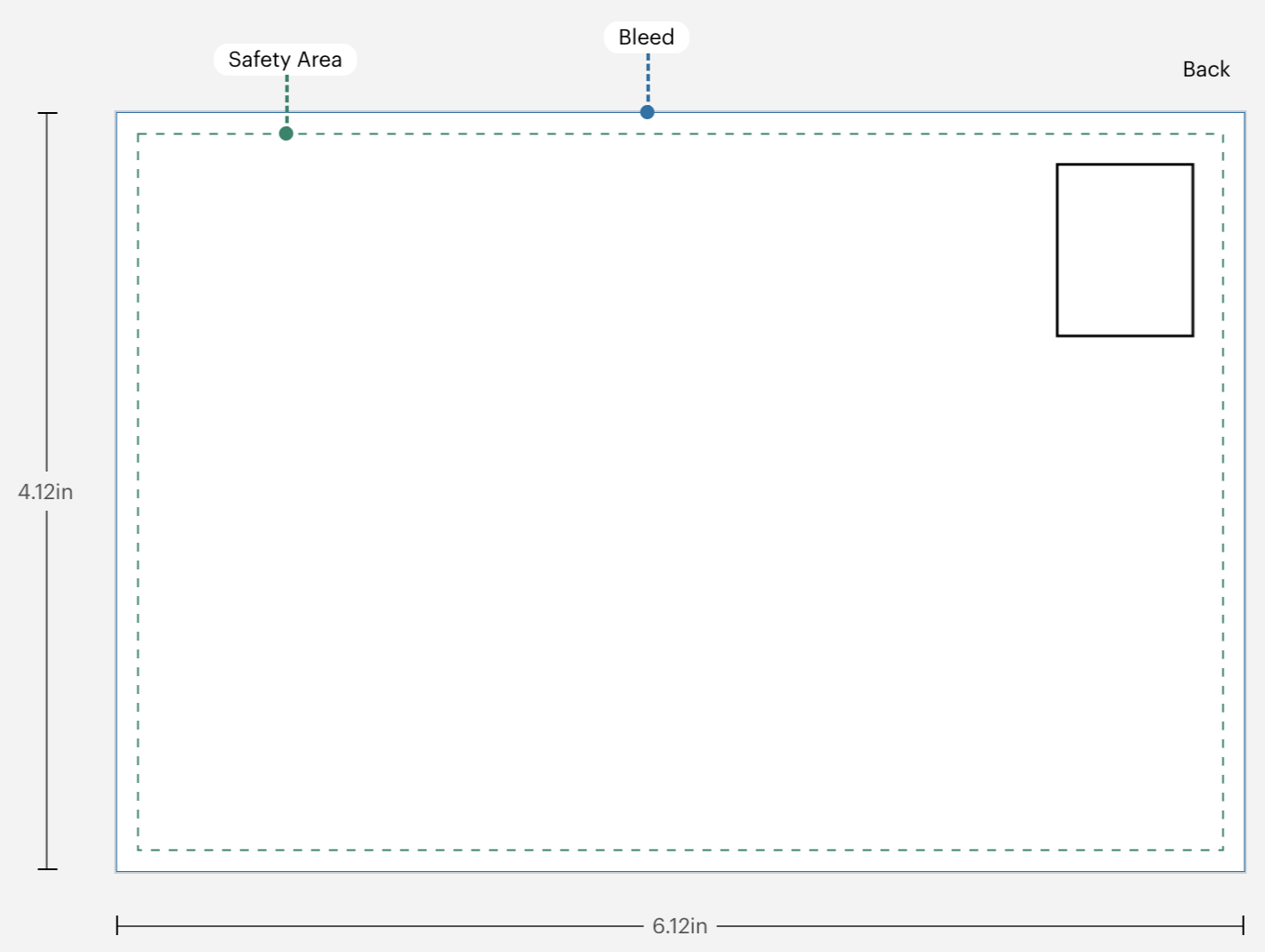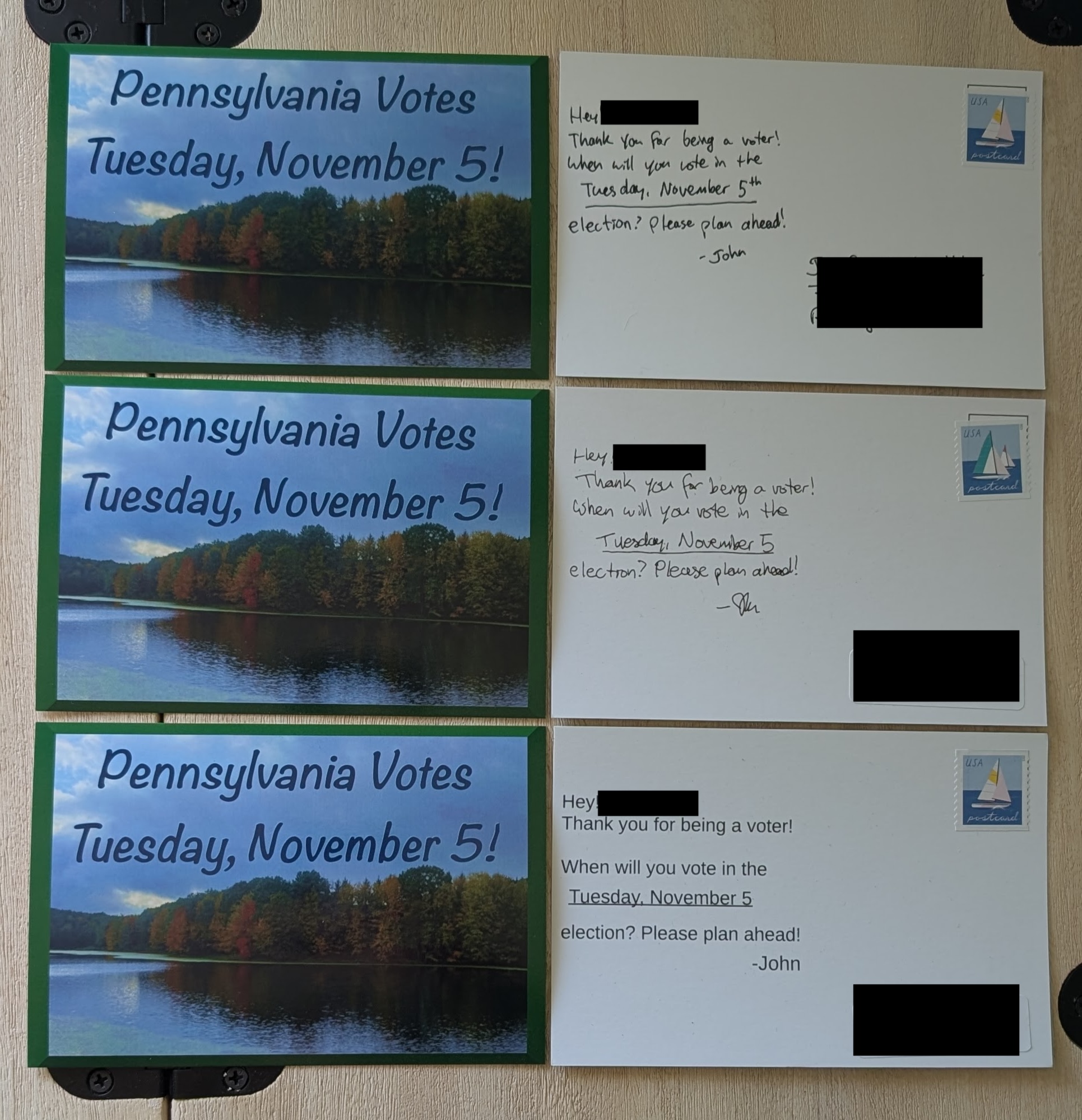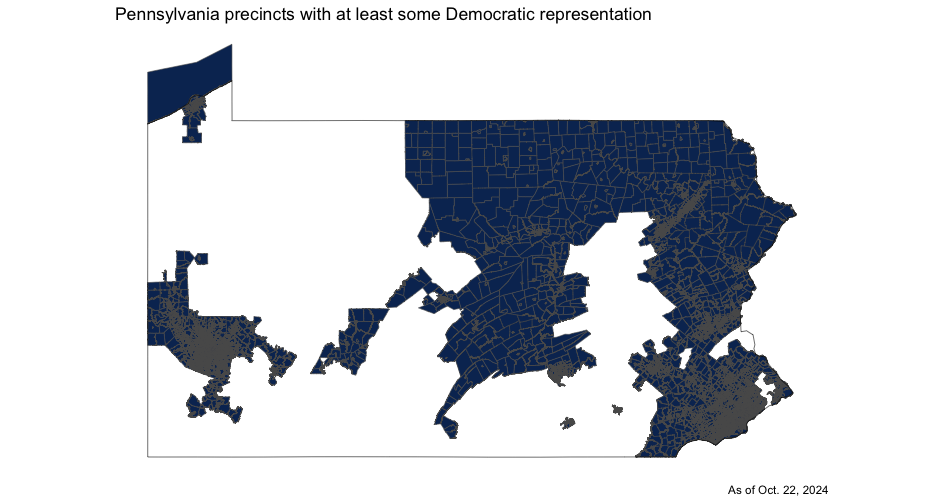Typical of a political operative in an even-numbered year, I’ve spent October wondering how much of the past year of my life has gone to waste.
I recently completed a fairly substantial hand-written postcard experiment, in which I wrote 3,200 postcards to voters in Florida and Pennsylvania. The messages varied, but the basic construction of the postcards was similar: A paragraph of black text, an “ask” composed of various red, black, and blue text, and an address block - all written by hand. As I described in the post, this became something of a daily ritual for me, setting aside time usually first thing in the morning before starting my day to knock out a stack of ten or twenty. While tolerable and sometimes even meditatively pleasant in small batches, the amount of time I spent writing the things added up.
At the time, I wanted to interrogate whether handwriting these postcards was the optimal approach. But because the nature of the experiment was already somewhat novel - the intent was to change the party identification of low-turnout Republicans - it felt unwise to try and pile too many randomizations on top of each other. Here, in a somewhat simpler experiment with a more straightforward treatment - asking 1,528 low-turnout Pennsylvania Democrats to turn out to vote - I describe an experiment designed to measure the impact of handwriting on the efficacy of postcards to voters.
Motivation
Handwritten postcards have several purported benefits. The postcard is a rare form of voter contact that can be front-loaded, i.e., prepared long in advance and then mailed out at an optimal time. Creating them can bring activists together - indeed, its utility as a voter contact method is often spoken in the same breath as its utility as a means of fostering interaction between volunteers, which has obvious downstream benefits. Handwriting is generally thought to signal authenticity (though I also wonder if it signals “I put a lotta work into bothering you, so you better go vote in this damn thing!”).
Others have interrogated these premises. For example, in an experiment focused on a 2022 Arizona primary Sister District found that completely handwritten postcards were marginally more effective than partially handwritten postcards, to the tune of about half a percentage point of turnout in a relatively low-salience election. In 2018 TMC and Coalition for a Better Illinois found found that handwritten postcards sent to “drop-off voters” improved turnout by about 1.2 percentage points compared to a holdout group that was not sent any postcards. TMC has done a lot of work on postcards and it looks like consensus is they typically help improve turnout somewhere in the +0.2-+0.4 range. Not bad!
To date, research on postcards seems mostly interested in knowing whether postcards work or not, with some interest in the logistical character of a postcard program (how many do we send, at what interval, etc.). The most well-known experiment in this area compared “handwritten” to “partially handwritten” postcards - fairly human labor-intensive, either way. For organizations, this is sensible - the labor is outsourced to activists who want to engage in it anyway, and this type of labor is rumored to help strengthen local activist networks.
I am skeptical that this is an optimal arrangement. Writing large numbers of postcards can really be a pain. Stamps ain’t free. The sheer monotony of postcard writing - and the fact that alcohol and socializing generally slow and degrade the writing - makes me wonder if activists really like this sort of thing or if it saps their energy. I’ve never seen a systematic analysis of activist fatigue of this kind. But more fundamentally, even if the product has value, there are indisputably faster (and equally cheap) ways to reproduce whatever the effects of handwriting are, such as by simply mass printing a handwritten message onto the postcards. This would eliminate the potential downstream impact of postcards on volunteer connectedness, but would also free up activist time to do other activities to increase turnout (such as hosting barbecues near voting sites ). This experiment compares the turnout effects of fully handwritten postcards, fully non-handwritten postcards, and what I will call “facsimile handwritten” postcards: postcards where the ask was written once and simply copied at the printer, with the greeting name and delivery addresses piped in using a handwriting-style typeface.
Research design: Handwritten, typed, and facsimile handwritten postcards
To interrogate the tradeoffs involved in postcard campaigns, I prepared an experiment to measure the impact three types of postcards may have on turnout. These include fully handwritten postcards, fully typed postcards, and facsimile handwritten postcards, on which a handwritten message and address are printed directly onto the cards rather than being handwritten fresh on each postcard. The postcards were mailed to random samples of low-turnout Democratic voters in Pennsylvania in October, 2024.
The postcards
The postcards were standard 4”x6” cardboard with a glossy front and non-glossy back. The back of the postcards were unadorned except for an outlined box in the upper righthand corner to indicate where to place the stamp. I designed the image for the front of the postcards in GIMP, placing a simple message (“Pennsylvania votes Tuesday, November 5!”) over a pleasant image of the Mira Lloyd Dock Center in Spring Mills, PA available on the Pennsylvania Department of Conservation and Natural Resources’s Fall Foliage Guide. I added a racing stripe around the image in Pantone PMS 349 C, the shade of green used in the wreath of the Pennsylvania state flag, which I feel is pretty sharp. The text was written in a combination of Pantone PMS 648 C bordered by Pantone PMS 636 C, which are the shades of blue used on the Pennsylvania state flag. The typeface is Noteworthy Bold.


Across conditions, I used a fairly straightforward election day reminder, following the recommended language used by groups such as the Progressive Turnout Project and their Postcards to Swing State Voters project:
Hey [first name]!
Thank you for being a voter! When will you vote in the Tuesday, November 5th election? Please plan ahead!
Best, John
(These groups also often recommend social pressure-based reminders, or “remind your friends and family”-based reminders, with research backing up each of these approaches)
Recipients received this message either handwritten, typed (in the Arial typeface), or in the form of a mass-printed version of the handwritten text, with their address printed using a custom handwriting-based typeface onto an address label. A postcard in each respective condition looked like so:

In total, I made 1,528 postcards. This includes 510 handwritten postcards, 510 typed postcards, and 508 facsimile handwritten postcards. I ordered postcards in each condition in batches of 500, but for some reason VistaPrint overloaded each batch slightly - presumably due to a love of applied social science. For how little they cost, I will say I was pleasantly surprised by the quality of the “facsimile handwritten” postcards - it is very difficult to discern them from the fully handwritten version, in my opinion. The postcards cost about $0.10 per postcard including taxes and rush shipping (I had just finished my big experiment for the cycle a few days beforehand and wanted to make sure I had time for this one, too) for a total cost of $155.57. To my surprise, the postcards in each condition cost the same, even though the facsimile handwritten and the fully typed postcards had the glossy image on one side and printed text on the other, whereas the handwritten postcards only had the glossy image. Maybe they jacked up the price of the handwritten condition because the box for stamp placement counts as two-sided printing, or something. The mysteries of political research.
For the two conditions that required printing address labels, the labels were printed on 0.66” * 2.1” DK-1204 sticker labels, on my Brother QL-810W label maker, using leftover labels from the other experiment plus one additional roll of 400 which sells for $16 apiece, up to about $18.50 with shipping and taxes. The printed labels for the fully typed condition looked like so:

And the printed labels in the facsimile handwritten condition looked like so:

Each postcard was stamped with a $0.56 postcard stamp, at a total postage cost of $855.68. All 1,528 postcards were mailed on October 22, 2024 from a post office located in Austin, Texas.

While this is less than half the size of my previous experiment and so the total collection altogether is not quite as dramatic in appearance, it managed to take up most of a full USPS tray when I dropped them off. A USPS employee helped me stack them in the tray and it was a busy afternoon with a line behind me, so I opted not to take a photo of the fully arrayed postcards in their postcard tray on site. Talk about social pressure!
The target universe: Low-turnout Democratic voters in Pennsylvania who do not live in very red areas
The universe for this study includes low-turnout Democratic voters residing in precincts in Pennsylvania that have at least some Democratic representation. Bearing in mind that neither my employer nor any of my clients had any involvement in this project, I estimated turnout propensity on the Pennsylvania voterfile using only the information on that file - no propensity scores, polling, etc. I defined the sample universe as voters in Pennsylvania who are
- Currently active on the voterfile
- Registered Democrat
- Did not vote in at least one of the 2016 and 2020 general elections - i.e., skipped both, skipped just 2016, or skipped just 2020
- Does not vote in primaries, with this definition using a cutoff of not having voted in any primary in the last ten years
- Is registered to vote in a precinct that in the most recent election provided majority support to at least one of the Democratic candidate for Congress, State Senate, or State House (this is mostly to ensure the registered Democrat has a reasonably high probability of voting Democratic should they vote)
In total, this included a sample universe of 538,451 Pennsylvania voters residing across the parts of Pennsylvania with Democratic representation at the State House, State Senate, or Congressional level:

Unlike the other experiment I ran this cycle I have no theory as to whether this experiment will change Democratic electoral performance - indeed, I deliberately cut the sample to increase the likelihood every additional voter generated by the experiment would yield an additional Democratic vote. As such, this experiment does not have additional block randomization - just a random sample drawn from the sample universe, and divided into the three treatment conditions. In total, this includes 510 respondents in the handwritten postcards condition, 510 respondents in the typed postcards condition, and 508 respondents in the facsimile handwritten postcards condition.
Outcomes of Interest
In addition to adding another data point to the ongoing research question of whether postcards work at all, this experiment will compare any such impact across three postcard designs: fully handwritten postcards, fully typed postcards, and fully “handwritten but printed” facsimile-handwritten postcards. As such, the primary outcome of interest is simply the turnout rate differential between voters who receive “any postcard” or “no postcard,” and the turnout rate differential between voters who receive “handwritten postcards,” “fully typed postcards,” “facsimile postcards,” and the control.
While prior research suggests it is plausible that the handwritten and facsimile-handwritten postcards slightly outperform the typed postcards, I do not think it is plausible that handwritten postcards and facsimile-handwritten postcards will differ much in their impact on turnout. One really has to squint to tell the difference between the two, and people are generally not in the habit of even looking at postcards, let alone squinting at them. I think if people knew they were looking at facsimile handwriting they’d really hate it, but I don’t think anybody is plausibly going to interrogate their treatment materials that closely.
This experiment contacted 1,528 voters at a total project cost of $1,029.75 – and, thanks to fully 2/3rds of the postcards being machine printed, at a much faster pace than a fully handwritten version would have taken. Additionally, as the turnout message here was nice and short (deliberately so, to be sure), completing this project start to finish took one person operating at political-hack-in-October-of-an-election-year energy levels barely two weeks to complete. In terms of an activist’s time, I can already tell you there are savings to be had here.
Now that I have handwritten a lot of postcards I think its worthwhile to seriously interrogate whether or not the effort is worthwhile. A nice, well-crafted, visually-appealing handwritten postcard is actually somewhat time-intensive to prepare, and while getting political activists involved in these sorts of activities may be important for its own sake, I look forward to having data telling us whether its really our best use of time or if there are other activities we can consider.